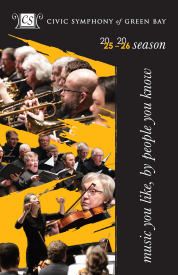Program Notes
Wizards, Whips, & Wookiees
Civic Symphony of Green Bay
Saturday, October 18, 2025
Cofrin Family Hall • The Weidner
OVERVIEW
Lightsabers, dinosaurs, and a dash of magic! Join the Civic Symphony of Green Bay for a musical journey through the iconic film scores of John Williams. From the galaxy-shaking grandeur of Star Wars and the thrilling pulse of Indiana Jones, to the wonder of E.T., Jurassic Park, and beyond—this concert is a cinematic celebration for all ages. The orchestra will be joined on stage in the second half by singers from the Dudley Birder Chorale, the Badger State Girl Choir, and the Badger State Festival Singers.
This concert is presented in partnership and with support from The Weidner.
ABOUT THE COMPOSER
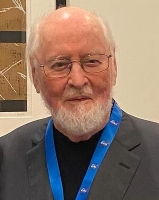 Born in New York City during Bernstein’s early success, John Williams was in school band and joined the Air Force as a professional musician. His first job composing was for military base commercials. After serving, Williams wrote music for small projects until hitting it big with Star Wars, called “the greatest film score of all time” by the American Film Institute. John Williams is known for scoring some of the top soundtracks in film, including the pieces you’ll hear today and many, many more. He continues to compose for orchestras and work with ensembles around the world, and has accumulated many award nominations over his career as composer for film and television:
Born in New York City during Bernstein’s early success, John Williams was in school band and joined the Air Force as a professional musician. His first job composing was for military base commercials. After serving, Williams wrote music for small projects until hitting it big with Star Wars, called “the greatest film score of all time” by the American Film Institute. John Williams is known for scoring some of the top soundtracks in film, including the pieces you’ll hear today and many, many more. He continues to compose for orchestras and work with ensembles around the world, and has accumulated many award nominations over his career as composer for film and television:
- 54 Academy Awards (5 wins)
- 6 Emmy Awards (3 wins)
- 25 Golden Globe Awards (4 wins)
- 76 Grammy Awards (26 wins)
- 16 British Academy Film Awards (7 wins)
- 23 Saturn Awards (10 wins)
REPERTOIRE
Click a title below to expand and read about the pieces on this afternoon’s program. We hope you learn something new and interesting about the composer and the music. If you have time in the next two weeks, please share your feedback in our concert survey.
Remember to silence your cell phone and refrain from texting, audio/video recording, or flash photography during the performance.
AT A GLANCE
Title: Star Wars Suite for Orchestra
Composed: 1977
Length: approx. 15 minutes total (3 movements)
Instrumentation: 3 flutes (third doubling piccolo), 2 oboes + English horn, 2 clarinets + bass clarinet, 2 bassoons, 4 horns, 3 trumpets, 3 trombones, tuba, timpani, percussion (bass drum, cymbals, glockenspiel, snare drum, suspended cymbal, tam-tam, triangle, vibraphone), harp, piano/celeste, and strings
Previous performances: CSGB premiere performance of this suite. The orchestra performed different arrangements of the Star Wars Main Theme on 4/20/2008, 11/11/2016, & 2/17/2023
ABOUT THE MOVIE
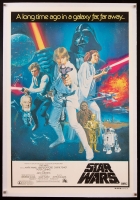 Released on May 25, 1977, Star Wars was an instant sensation to the public. Created by George Lucas, the original movie trilogy, starring Harrison Ford, Carrie Fisher, and Mark Hamill, grew to become one of the most enduring franchises in the history of film. The epic space opera is set “A long time ago in a galaxy far, far away…” where humans, space aliens, and semi-sentient robots co-exist and travel amongst the stars in faster-than-light ships powered by hyperspace drives. The film saga follows the story of farm boy Luke Skywalker, Rebel Leader Princess Leia Organa, Han Solo (a smuggler by trade) and his hairy alien companion Chewbacca, the droids C-3PO and R2-D2, and the evil Darth Vader. Star Wars: A New Hope, the first movie released, begins with an opening screen crawl setting the scene. The evil Galactic Empire battles to control the galaxy while the Rebel Alliance fights for freedom and independence.
Released on May 25, 1977, Star Wars was an instant sensation to the public. Created by George Lucas, the original movie trilogy, starring Harrison Ford, Carrie Fisher, and Mark Hamill, grew to become one of the most enduring franchises in the history of film. The epic space opera is set “A long time ago in a galaxy far, far away…” where humans, space aliens, and semi-sentient robots co-exist and travel amongst the stars in faster-than-light ships powered by hyperspace drives. The film saga follows the story of farm boy Luke Skywalker, Rebel Leader Princess Leia Organa, Han Solo (a smuggler by trade) and his hairy alien companion Chewbacca, the droids C-3PO and R2-D2, and the evil Darth Vader. Star Wars: A New Hope, the first movie released, begins with an opening screen crawl setting the scene. The evil Galactic Empire battles to control the galaxy while the Rebel Alliance fights for freedom and independence.
ABOUT THE MUSIC
John Williams got much of his inspiration for the music for Star Wars from both classical music and soundtracks from the Golden Age of Hollywood. He cited composers Max Steiner and Erich Korgold for their use of music to enhance dialogue. From the world of classical music, Williams drew inspiration from Igor Stravinsky, Sergei Prokofiev, and Gustav Holst. One of the largest influences for Williams was Richard Wagner and his use of the compositional device known as a “leitmotif” – a recurring musical phrase or quote to denote a particular person, place, object, or feeling. Wagner made heavy use of this device in his well-known cycle of four operas, Der Ring des Nibelungen (The Ring of the Nibelungen). One example within the operas is “The Ride of the Valkyries.” That melody is written in many permutations to fit the mood or setting as needed in the story of the opera, but the core theme is still recognizable.
The Civic Symphony of Green Bay will perform three movements from Star Wars Suite. John Williams used many leitmotifs in Star Wars. One melody that appears throughout all the films is “Princess Leia’s Theme” which you’ll hear in the second movement of the suite today. The melancholy melody is introduced by a solo horn played by the Civic Symphony’s own Andy Parks, and then our principal flute Rose van Himbergen takes over the theme, embellishing it with a virtuosic flourish of notes. The orchestra will also perform the “Main Theme” from Star Wars as well as “The Imperial March” with leitmotifs from many points in Star Wars: A New Hope. In these movements, listen for the influences of Stravinsky in the strings and heroic brass fanfares influenced by Wagner and Holst.
AT A GLANCE
Title: Raiders March from Raiders of the Lost Ark
Composed: 1981
Length: 5.5 minutes
Instrumentation: 3 flutes (third doubling piccolo), 3 oboes (third doubling English horn), 3 clarinets (third doubling bass clarinet), 3 bassoons (third doubling contrabassoon), 4 horns, 4 trumpets, 4 trombones, tuba, timpani, percussion (bass drum, cymbals, glockenspiel, snare drum, triangle, vibraphone), harp, piano/celeste, and strings
CSGB premiere performance
ABOUT THE MOVIE
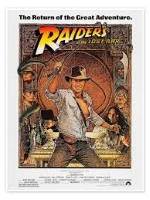 First conceived by George Lucas in 1973, then later directed by Steven Spielberg, Raiders of the Lost Ark became the beginning to a long-running, five-film franchise. The story follows our hero, Indiana Jones – a professor of archeology, academic of history, and antiquarian. Known to his companions as “Indy,” he goes on adventures seeking out historical relics such as the Ark of the Covenant in the film Raiders of the Lost Ark and the Holy Grail in Indiana Jones and the Last Crusade.
First conceived by George Lucas in 1973, then later directed by Steven Spielberg, Raiders of the Lost Ark became the beginning to a long-running, five-film franchise. The story follows our hero, Indiana Jones – a professor of archeology, academic of history, and antiquarian. Known to his companions as “Indy,” he goes on adventures seeking out historical relics such as the Ark of the Covenant in the film Raiders of the Lost Ark and the Holy Grail in Indiana Jones and the Last Crusade.
The character of Indiana Jones was developed by Spielberg and Lucas in the style of 20th century pulp magazines which told grandiose stories, sensationalized to make them seem larger than life. According to film producer Frank Marshall, while being almost superhero-like, Indiana Jones is “…a fallible character. He makes mistakes and gets hurt. That’s the other thing people like: he’s a real character, not a character with superpowers.”
ABOUT THE MUSIC
John Williams began composing the score from the standpoint that the music didn’t need to be as serious as other film scores. He intentionally wrote it to sound theatrical and excessive, matching the style in which the character of Indiana Jones was written. Within weeks Williams had created two separate pieces. One had a march-like feel designed to embody the brave nature of Indiana Jones. The other piece was more sweeping and romantic, outlining the heart and humanity of the character. When Williams presented the two musical options to Steven Spielberg, they decided to combine them to make the theme we know and love today. The piece opens with the heroic march, and the center section uses the sweeping, romantic melody as contrast. The music finishes with a return to the march fanfare featuring the entire brass section.
AT A GLANCE
Title: Born on the Fourth of July
Composed: 1989
Length: 7 minutes
Instrumentation: solo trumpet in C, 3 horns, tuba, timpani, suspended cymbal, harp, and strings
CSGB premiere performance
ABOUT THE MOVIE
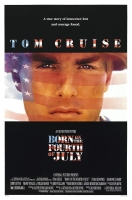 Released in 1989, the autobiographical film Born on the Fourth of July follows the life of Vietnam War veteran Ron Kovic (played by film megastar Tom Cruise). The screenplay was written by Kovic and director Oliver Stone, exploring the themes of patriotism, trauma, betrayal, and redemption. It’s based on Kovic’s autobiographical book of the same title which chronicles his journey from childhood, to his military service during the Vietnam War where he was paralyzed, and through his post-war activism. Born on the Fourth of July became the 10th highest grossing film in 1989, resulting in eight Academy Award nominations including Tom Cruise’s first ever nomination for Best Actor and Best Original Score for John Williams. Coincidentally, Williams was also nominated in the same category for Indiana Jones and The Last Crusade the same year. Born on the Fourth of July won Oscars for Best Director – Stone’s second win in that category – and Best Film Editing.
Released in 1989, the autobiographical film Born on the Fourth of July follows the life of Vietnam War veteran Ron Kovic (played by film megastar Tom Cruise). The screenplay was written by Kovic and director Oliver Stone, exploring the themes of patriotism, trauma, betrayal, and redemption. It’s based on Kovic’s autobiographical book of the same title which chronicles his journey from childhood, to his military service during the Vietnam War where he was paralyzed, and through his post-war activism. Born on the Fourth of July became the 10th highest grossing film in 1989, resulting in eight Academy Award nominations including Tom Cruise’s first ever nomination for Best Actor and Best Original Score for John Williams. Coincidentally, Williams was also nominated in the same category for Indiana Jones and The Last Crusade the same year. Born on the Fourth of July won Oscars for Best Director – Stone’s second win in that category – and Best Film Editing.
ABOUT THE MUSIC
John Williams composed the score of Born on the Fourth of July to evoke feelings of reflection, pain, and mournfulness. His writing here is more elegy-like, creating a deeply emotional atmosphere as opposed to some of his other compositions. One of the most notable features of the theme from Born on the Fourth of July is a sorrowful trumpet solo. The original recording was performed by Tim Morrison, principal trumpet of the Boston Pops Orchestra from 1987 to 1997. Williams chose Morrison for the part stating, “He has an American sound and his sound is very touching, very beautiful. There is real serenity in his playing.” This afternoon the Civic Symphony of Green Bay will recreate the mournful feel of the music with the solo performed by our own principal trumpet, Dan Marbes.
AT A GLANCE
Title: Theme from Jurassic Park
Composed: 1993
Length: 6 minutes
Instrumentation: 3 flutes (third doubling piccolo), 2 oboes + English horn, 2 clarinets + bass clarinet, 3 bassoons (third doubling contrabassoon), 4 horns, 3 trumpets, 3 trombones, tuba, timpani, percussion (chimes, cymbals, glockenspiel, mark tree, suspended cymbal, triangle), harp, piano, and strings
CSGB premiere performance
ABOUT THE MOVIE
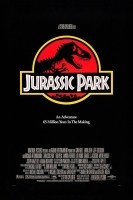 Released in 1993 and directed by Steven Spielberg, Jurassic Park is a science-fiction film based on the novel of the same title written by Michael Crichton. The movie follows the story of a literally larger-than-life nature preserve on the fictional island of Isla Nublar near Costa Rica. The park, envisioned by industrialist John Hammond (played by Richard Attenborough), is home to dinosaurs brought back from extinction with the use of modern DNA splicing. Hammond invites scientists Alan Grant (Sam Neill), Ellie Sattler (Laura Dern), and mathematician Ian Malcolm (Jeff Goldblum) to ensure the island is clear of danger after a park worker is killed by a velociraptor. Hammond also invites his grandchildren to the park. The story develops with increasing peril as the dinosaurs escape and begin attacking the humans in the park until all the main characters – including the young children (phew!) – are able to escape the island. Jurassic Park became the highest grossing film in movie history until it was surpassed by Titanic in 1997. It also garnered three Academy Award nominations and won for Best Sound, Best Sound Effects Editing, and Best Visual Effects.
Released in 1993 and directed by Steven Spielberg, Jurassic Park is a science-fiction film based on the novel of the same title written by Michael Crichton. The movie follows the story of a literally larger-than-life nature preserve on the fictional island of Isla Nublar near Costa Rica. The park, envisioned by industrialist John Hammond (played by Richard Attenborough), is home to dinosaurs brought back from extinction with the use of modern DNA splicing. Hammond invites scientists Alan Grant (Sam Neill), Ellie Sattler (Laura Dern), and mathematician Ian Malcolm (Jeff Goldblum) to ensure the island is clear of danger after a park worker is killed by a velociraptor. Hammond also invites his grandchildren to the park. The story develops with increasing peril as the dinosaurs escape and begin attacking the humans in the park until all the main characters – including the young children (phew!) – are able to escape the island. Jurassic Park became the highest grossing film in movie history until it was surpassed by Titanic in 1997. It also garnered three Academy Award nominations and won for Best Sound, Best Sound Effects Editing, and Best Visual Effects.
ABOUT THE MUSIC
John Williams makes use of the leitmotif in Jurassic Park, albeit not as much as other scores he composed. The Theme from Jurassic Park recreates the wonder a child may feel when first realizing that dinosaurs are alive. The same melody permeates through the movie in different forms to enhance emotions felt throughout. This afternoon, listen for the Civic Symphony of Green Bay to play the lyrical melody at the start of the piece, and observe it move throughout the orchestra in different tonal colors and dynamics. Halfway through, the orchestral tone shifts gears to the brass section for a more fanfare-like setting written by Williams to evoke emotions of grandeur and exploration.
AT A GLANCE
Title: Somewhere in My Memory from Home Alone
Composed: 1990
Length: 4 minutes
Instrumentation: 3 flutes (third doubling piccolo), 2 oboes + English horn, 3 clarinets (third doubling bass clarinet), 3 bassoons, 4 horns, 3 trumpets, 3 trombones, tuba, timpani, percussion (bell tree, chimes, glockenspiel, sleighbells, suspended cymbal, vibraphone), harp, piano/celeste, strings, chorus, and children’s chorus
Previous performances: CSGB premiere performance. The Dudley Birder Chorale frequently features this selection at their annual Holiday Pops concert.
ABOUT THE MOVIE
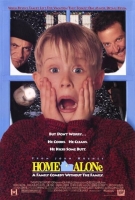 Released in 1990, Home Alone was written and produced by John Hughes, directed by Chris Columbus, and orchestrated by John Williams. It remained at the No. 1 spot at the box office for 12 weeks from its release on the weekend of November 16, 1990 all the way to February 1, 1991. The story follows the Christmas vacation plans of the McCallister family from suburban Chicago. The rambunctious Kevin McCallister (played by Macaulay Culkin) ends up being grounded by his parents Peter (John Heard) and Kate (Catherine O’Hara) and forced to sleep in one of the guest beds in the attic of the house. After a power outage and a horrible mix-up, eight-year-old Kevin is forgotten at home while the family flies off to Paris, France. Two professional burglars (played by Joe Pesci and Daniel Stern) eye up the McCallister house for the taking, but they do not know Kevin is still home alone. The film explores the themes of independence, growth, family, forgiveness, and the holiday spirit – causing it to become one of the quintessential Christmas movies to rewatch every year.
Released in 1990, Home Alone was written and produced by John Hughes, directed by Chris Columbus, and orchestrated by John Williams. It remained at the No. 1 spot at the box office for 12 weeks from its release on the weekend of November 16, 1990 all the way to February 1, 1991. The story follows the Christmas vacation plans of the McCallister family from suburban Chicago. The rambunctious Kevin McCallister (played by Macaulay Culkin) ends up being grounded by his parents Peter (John Heard) and Kate (Catherine O’Hara) and forced to sleep in one of the guest beds in the attic of the house. After a power outage and a horrible mix-up, eight-year-old Kevin is forgotten at home while the family flies off to Paris, France. Two professional burglars (played by Joe Pesci and Daniel Stern) eye up the McCallister house for the taking, but they do not know Kevin is still home alone. The film explores the themes of independence, growth, family, forgiveness, and the holiday spirit – causing it to become one of the quintessential Christmas movies to rewatch every year.
ABOUT THE MUSIC
John Williams earned two Academy Award nominations for Home Alone: Best Original Score and Best Original Song for “Somewhere in My Memory.” He also received a Grammy nomination in the category of Best Song Written for Visual Media. The song “Somewhere in My Memory” has grown in such popularity that it is now an annual standard performed at Christmastime. Today you will hear the orchestra and children’s choir evoke feelings of magic and nostalgia as the gentle melody flows throughout the ensemble.
LYRICS
Candles in the window
Shadows painting the ceiling
Gazing at the fire glow
Feeling that gingerbread feeling
Precious moments, special people
Happy faces, I can see
Somewhere in my memory
Christmas joys all around me
Living in my memory
All of the music, all of the magic
All of the family home here with me
AT A GLANCE
Title: Double Trouble from Harry Potter and the Prisoner of Azkaban
Composed: 2004
Length: 3 minutes
Instrumentation: 3 flutes (third doubling piccolo), 3 oboes (third doubling English horn), 3 clarinets (third doubling bass clarinet), 3 bassoons (third doubling contrabassoon), 4 horns, 3 trumpets, 3 trombones, tuba, timpani, percussion (bass drum, bell tree, cymbals, glockenspiel, medium low drum, sleighbells, suspended cymbal, tambourine, triangle), harp, piano/celeste, strings, and children’s chorus
CSGB premiere performance
ABOUT THE MOVIE
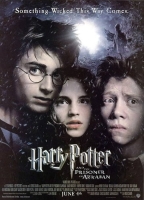 Released in 2004, Harry Potter and the Prisoner of Azkaban is the third installment of the popular Harry Potter films. The movies follow the life of young Harry Potter (played by Daniel Radcliffe). Harry attends school at the Hogwarts School of Witchcraft and Wizardry. A news headline is shared throughout the wizarding world that a prisoner has escaped from Azkaban – a prison where wizards and witches are sentenced for heinous crimes. The film opened in the United States on June 4, 2004 and had the third biggest opening weekend of all time.
Released in 2004, Harry Potter and the Prisoner of Azkaban is the third installment of the popular Harry Potter films. The movies follow the life of young Harry Potter (played by Daniel Radcliffe). Harry attends school at the Hogwarts School of Witchcraft and Wizardry. A news headline is shared throughout the wizarding world that a prisoner has escaped from Azkaban – a prison where wizards and witches are sentenced for heinous crimes. The film opened in the United States on June 4, 2004 and had the third biggest opening weekend of all time.
ABOUT THE MUSIC
Harry Potter and the Prisoner of Azkaban was the last Harry Potter film that John Williams orchestrated – but it would not be without accolade as Williams was nominated for the Academy Award for Best Original Score that year. The most memorable piece from the film is “Double Trouble” which captures the balance of whimsy and menace within the film. The song is performed with orchestra and children’s choir. Williams chose the lyrics from Shakespeare’s Macbeth, Act IV, scene 1. The melody given to the lyrics is shared by not only the choir but many sections within the orchestra, as you will hear this afternoon.
LYRICS
Fire burn and cauldron bubble
Double, double, toil and trouble
Something wicked this way comes!
Eye of newt and toe of frog
Wool of bat and tongue of dog
Ander’s fork and blind worm’s sting
Lizard’s leg and owlet’s wing
Double, double, toil and trouble
Fire burn and cauldron bubble
Something wicked this way comes!
AT A GLANCE
Title: Flying Theme from E.T. the Extra-Terrestrial
Composed: 1982
Length: 4 minutes
Instrumentation: 3 flutes (third doubling piccolo), 2 oboes, 2 clarinets, 3 bassoons, 4 horns, 3 trumpets, 3 trombones, tuba, timpani, percussion (chimes, cymbals, glockenspiel, suspended cymbal, triangle), harp, piano/celeste, and strings
Previous performances: CSGB premiere performance of this original version. The orchestra performed Selections from E.T. on 2/17/2023 & 7/1/2023
ABOUT THE MOVIE
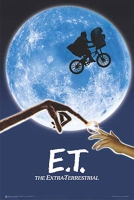 Produced and directed by Steven Spielberg with screenwriting by Melissa Mathison, the science-fiction classic E.T. The Extra-Terrestrial was released in 1982. It follows the story of a young boy named Elliot who discovers and befriends an extra-terrestrial being who has been stranded on Earth. Elliot names the being E.T. and together they grow a strong friendship and emotional bond. Eventually they must run from authorities trying to capture E.T. to study him. The origin of the story is from Spielberg’s own youth. Spielberg states that as a child, he created an imaginary friend to fill the void in his life created after his parents’ divorce in 1960. The film was nominated for nine Academy Awards, winning in the categories of Best Sound, Best Visual Effects, Best Sound Editing, and of course, Best Original Score.
Produced and directed by Steven Spielberg with screenwriting by Melissa Mathison, the science-fiction classic E.T. The Extra-Terrestrial was released in 1982. It follows the story of a young boy named Elliot who discovers and befriends an extra-terrestrial being who has been stranded on Earth. Elliot names the being E.T. and together they grow a strong friendship and emotional bond. Eventually they must run from authorities trying to capture E.T. to study him. The origin of the story is from Spielberg’s own youth. Spielberg states that as a child, he created an imaginary friend to fill the void in his life created after his parents’ divorce in 1960. The film was nominated for nine Academy Awards, winning in the categories of Best Sound, Best Visual Effects, Best Sound Editing, and of course, Best Original Score.
ABOUT THE MUSIC
Steven Spielberg would once again bring John Williams into the folds of his films to create the score for E.T. the Extra-Terrestrial. One of the challenges Williams faced was how to write music to invoke sympathy for “such an odd-looking creature.” The score that Williams composed impressed Spielberg so much that he changed scenes in the movie to better suit what Williams had written. One very interesting easter egg in the film is when Elliot, his friends, and E.T. walk amongst some Halloween trick-or-treaters. With E.T. hidden behind a white sheet disguised as a ghost, they spot another child dressed as Yoda from Star Wars Episode V: The Empire Strikes Back. E.T. turns to the child and starts saying “Home…home…” while the instrumentals in the background play “Yoda’s Theme” from that movie. Arguably, the most recognizable piece from the E.T. score is the “Flying Theme.” The horns and strings carry much of the sweeping melody. The orchestration uses a fast, waltz-like style to create a feeling of wonder and flight.
AT A GLANCE
Title: The Shark Theme from Jaws
Composed: 1975
Length: 3 minutes
Instrumentation: 3 flutes (third doubling piccolo), oboe + English horn, 2 clarinets + bass clarinet, 2 bassoons + contrabassoon, 4 horns, 3 trumpets, 4 trombones, tuba, timpani, percussion (bass drum, chimes, cymbals, glockenspiel, hi-hat, snare drum, suspended cymbal, triangle, vibraphone, xylophone), harp, piano, and strings
CSGB premiere performance
ABOUT THE MOVIE
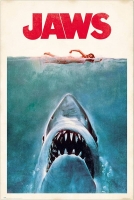 Released in 1975, Jaws is a thriller film directed by Steven Spielberg and based on a 1974 novel by Peter Benchley. Set in the fictional New England beach town of Amity Island, the story follows the path of terror carved out by a menacing great white shark. Near the beginning of the summer beach season, an unseen horror pulls a woman into the depths of the ocean while she is out for a night swim. Her partial remains are found on the beach the following morning. When it’s determined the woman was killed by a shark attack, the town police chief Martin Brody (played by Roy Scheider) intends to close the beaches until the shark goes away or is eliminated. The mayor of the town pushes to keep the beaches open which only allows more attacks to happen. The mayor then hires a professional shark hunter named Quint (Robert Shaw) and oceanographer Matt Hooper (Richard Dreyfuss) to deal with the shark.
Released in 1975, Jaws is a thriller film directed by Steven Spielberg and based on a 1974 novel by Peter Benchley. Set in the fictional New England beach town of Amity Island, the story follows the path of terror carved out by a menacing great white shark. Near the beginning of the summer beach season, an unseen horror pulls a woman into the depths of the ocean while she is out for a night swim. Her partial remains are found on the beach the following morning. When it’s determined the woman was killed by a shark attack, the town police chief Martin Brody (played by Roy Scheider) intends to close the beaches until the shark goes away or is eliminated. The mayor of the town pushes to keep the beaches open which only allows more attacks to happen. The mayor then hires a professional shark hunter named Quint (Robert Shaw) and oceanographer Matt Hooper (Richard Dreyfuss) to deal with the shark.
Jaws was an enormous success and helped coin the idea of a “summer blockbuster” for the future of the film industry. The movie broke box office records and became the highest-grossing film at the time. Jaws received an Academy Award nomination for Best Picture and won three Oscars for Best Film Editing, Best Sound, and Best Original Score. It also secured a Grammy Award win for Williams in the category of Best Score Written for Visual Media.
ABOUT THE MUSIC
John Williams chose an ominous two-note ostinato – a continually repeated musical phrase – to signify the presence of the great white shark in the movie. This two-note motif, alternating between the notes E and F, grows in intensity and rhythmicality as the shark approaches. The music begins in a low register of the orchestra using cello, bass, and bassoon to evoke a feeling of depth, as if the shark is deep under the water. The motif shifts up from the lower instruments into the trombone, viola, and clarinet and then eventually the high instruments including violin, trumpet, and flute. This shift is meant to make the listener feel as if the shark is starting to surface. Faster rhythms and more intense dynamics and articulations are used as the shark edges closer to attack. John Williams was quoted describing the Jaws theme as “grinding away at you, just as a shark would do, instinctual, relentless, unstoppable.”
AT A GLANCE
Title: Dry Your Tears, Afrika from Amistad
Composed: 1997
Length: 3.5 minutes
Instrumentation: 2 flutes (second doubling piccolo) + piccolo, 3 oboes (third doubling English horn), 3 clarinets (third doubling bass clarinet), 3 bassoons (third doubling contrabassoon), 4 horns, 3 trumpets, 3 trombones, tuba, timpani, percussion (African hand drums, bass drum, cymbals, glockenspiel, marimba, pulli sticks, suspended cymbal, tablas, tam-tam, xylophone), harp, piano, strings, chorus, and children’s chorus
CSGB premiere performance
ABOUT THE MOVIE
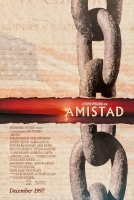 Released in 1997, the film Amistad is a historical drama directed by Steven Spielberg. The film illustrates the story of a slave ship called La Amistad (The Friendship). In 1839 La Amistad was setting sail from Cuba to a sugar plantation on the U.S. mainland carrying 53 kidnapped African people from Sierra Leone who were brought across the Atlantic illegally to be sold as slaves. On the journey from Cuba, one prisoner named Sengbe Pieh, also known as Joseph Cinque, had managed to break out of his shackles and free the other captives below deck on the third day at sea. This allowed the others to revolt and take control of the ship, killing the ship’s captain. Sengbe and his people kept the slave owners José Ruiz and Pedro Montes alive so they could navigate the ship back to Africa. Montes tricked Sengbe and sailed to Long Island, NY where they were eventually caught by the naval ship USS Washington. What followed was a legal journey of ethics, morality, and humanity in the U.S. Court system. In the end, Sengbe Pieh and his people were freed. Many went home while some stayed in the United States. The film Amistad starred Djimon Hounsou, Morgan Freeman, Matthew McConaughey, and Anthony Hopkins and debuted at No. 3 at the box office in December 1997. It also earned four Oscar nominations for Best Supporting Actor (Anthony Hopkins), Best Cinematography, Best Costume Design, and Best Original Dramatic Score (John Williams).
Released in 1997, the film Amistad is a historical drama directed by Steven Spielberg. The film illustrates the story of a slave ship called La Amistad (The Friendship). In 1839 La Amistad was setting sail from Cuba to a sugar plantation on the U.S. mainland carrying 53 kidnapped African people from Sierra Leone who were brought across the Atlantic illegally to be sold as slaves. On the journey from Cuba, one prisoner named Sengbe Pieh, also known as Joseph Cinque, had managed to break out of his shackles and free the other captives below deck on the third day at sea. This allowed the others to revolt and take control of the ship, killing the ship’s captain. Sengbe and his people kept the slave owners José Ruiz and Pedro Montes alive so they could navigate the ship back to Africa. Montes tricked Sengbe and sailed to Long Island, NY where they were eventually caught by the naval ship USS Washington. What followed was a legal journey of ethics, morality, and humanity in the U.S. Court system. In the end, Sengbe Pieh and his people were freed. Many went home while some stayed in the United States. The film Amistad starred Djimon Hounsou, Morgan Freeman, Matthew McConaughey, and Anthony Hopkins and debuted at No. 3 at the box office in December 1997. It also earned four Oscar nominations for Best Supporting Actor (Anthony Hopkins), Best Cinematography, Best Costume Design, and Best Original Dramatic Score (John Williams).
ABOUT THE MUSIC
The movie’s main theme titled “Dry Your Tears, Afrika” was composed by John Williams for orchestra and choir. The lyrics chosen were taken from a poem of the same title, written in 1967 by Bernard Binlin Dadié of the Ivory Coast. Williams had an excerpt of the poem translated from French into the African language of Mende, the native language of the imprisoned people aboard the ship La Amistad. Williams believed using children’s voices would be particularly effective to tell the dramatic story of the slaves fighting for freedom and returning to their homeland.
LYRICS
My Yama Mu Yeh, Afrika
AT A GLANCE
Title: Hymn to the Fallen from Saving Private Ryan
Composed: 1998
Length: 6 minutes
Instrumentation: 2 flutes, 2 oboes + English horn, 3 clarinets (second doubling bass clarinet, third doubling E-flat clarinet), 3 bassoons (third doubling contrabassoon), 4 horns, 3 trumpets, 3 trombones, tuba, timpani, percussion (deep military drum, glockenspiel, suspended cymbal), harp, strings, and chorus
Previous CSGB performances: 2/16/2019 & 10/28/2023
ABOUT THE MOVIE
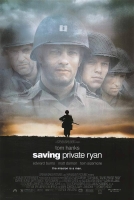 Directed by Steven Spielberg and written by Robert Rodat, Saving Private Ryan was released in July 1998. The film opens with the invasion of Normandy at Omaha Beach. At the end of the battle, the U.S. Department of War is notified of the deaths of three of four brothers. The department orders that the last brother, Private James Francis Ryan, be found and sent home to spare the family the loss of all four sons. The movie follows the story of a detachment of soldiers led by 2nd Ranger Battalion Capt. John Miller (played by Tom Hanks) to locate Private Ryan (Matt Damon). The movie follows the mission of Capt. Miller and his detachment as they move through France in search of Private Ryan.
Directed by Steven Spielberg and written by Robert Rodat, Saving Private Ryan was released in July 1998. The film opens with the invasion of Normandy at Omaha Beach. At the end of the battle, the U.S. Department of War is notified of the deaths of three of four brothers. The department orders that the last brother, Private James Francis Ryan, be found and sent home to spare the family the loss of all four sons. The movie follows the story of a detachment of soldiers led by 2nd Ranger Battalion Capt. John Miller (played by Tom Hanks) to locate Private Ryan (Matt Damon). The movie follows the mission of Capt. Miller and his detachment as they move through France in search of Private Ryan.
At the advice of military veterans, Spielberg decided he would shoot the film with a realistic portrayal set against the backdrop of actual events. He is quoted as saying, “I cannot tell you how many veterans came up to me and said: ‘Please be honest about it. Please don’t make another Hollywood movie about WWII. Please tell our stories.’” Saving Private Ryan is lauded for being one of the most realistic depictions of war in film. The film won five Academy Awards including Best Director, Best Cinematography, Best Sound, Best Film Editing, and Best Sound Effects Editing.
ABOUT THE MUSIC
John Williams was nominated for an Academy Award for Best Original Dramatic Score for Saving Private Ryan. Williams and Spielberg used a spotting process to best fit the musical score into the film. Spielberg wanted to ensure that the sounds of war and battle were more prominent than the music. As a result, Williams composed a score that avoided grandiose and operatic sounds. He used the orchestra to create a score with solemn, spiritual, and reflective tones with warm sounds provided by the string section. The wordless choir expresses grief and reverence beyond words.
AT A GLANCE
Title: Battle of the Heroes from Star Wars Episode III: Revenge of the Sith
Composed: 2005
Length: 3.5 minutes
Instrumentation: 3 flutes (third doubling piccolo), 2 oboes + English horn, 3 clarinets (second doubling E-flat clarinet, third doubling bass clarinet), 3 bassoons (third doubling contrabassoon), 4 horns, 4 trumpets, 3 trombones, tuba, timpani, percussion (anvil, chimes, cymbals, marimba, suspended cymbal, tam-tam, tubular bell, xylophone), harp, piano, strings, and chorus
CSGB premiere performance
ABOUT THE MOVIE
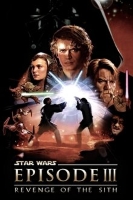 Released in 2005, Star Wars Episode III: Revenge of the Sith, is the third movie in the prequel trilogy of Star Wars. The events of the movie happen 19 years before the events of Star Wars: A New Hope. It follows the story leading to the creation of the Galactic Empire and Anakin Skywalker’s fall to the dark side of The Force. Anakin (played by Hayden Christensen) is vexed by nightmares and visions of the death of his wife Padme Amidala (Natalie Portman). This is all set against the backdrop of The Clone Wars. In this era of galactic history, a large group of Separatists have parted from the Galactic Republic and are fighting for galactic supremacy. The Army of the Republic consists of several million clones born and bred to fight the war for The Republic. This Clone Army is commanded by the Galactic Senate and The Jedi Order. Both Anakin Skywalker and Obi-Wan Kenobi (Ewan McGregor) are generals in charge of several battalions of troops.
Released in 2005, Star Wars Episode III: Revenge of the Sith, is the third movie in the prequel trilogy of Star Wars. The events of the movie happen 19 years before the events of Star Wars: A New Hope. It follows the story leading to the creation of the Galactic Empire and Anakin Skywalker’s fall to the dark side of The Force. Anakin (played by Hayden Christensen) is vexed by nightmares and visions of the death of his wife Padme Amidala (Natalie Portman). This is all set against the backdrop of The Clone Wars. In this era of galactic history, a large group of Separatists have parted from the Galactic Republic and are fighting for galactic supremacy. The Army of the Republic consists of several million clones born and bred to fight the war for The Republic. This Clone Army is commanded by the Galactic Senate and The Jedi Order. Both Anakin Skywalker and Obi-Wan Kenobi (Ewan McGregor) are generals in charge of several battalions of troops.
Anakin is tempted deeply by the dark side when he is told by Chancellor Palpatine (Ian McDiarmid) that, “The dark side of the Force is a pathway to many abilities some consider to be unnatural.” He shares a story he called “The Tragedy of Darth Plagueis the Wise” who was a powerful force user who could bring people back from death. Capitalizing on Anakin’s fear of losing Padme, Palpatine sets Anakin down the path to the dark side. Anakin believes the Jedi and the Galactic Senate are no longer to be trusted – and at the order of now Emperor Palpatine, begins the destruction of the Jedi Order. Obi-Wan learns the truth and moves to stop Anakin in what becomes one of the most iconic lightsaber combat scenes in Star Wars history.
ABOUT THE MUSIC
The most recognizable piece from Revenge of the Sith is “Battle of the Heroes.” This is the music that sets the tone for the last lightsaber duel between Anakin Skywalker and Obi-Wan Kenobi. George Lucas requested John Williams write something that was a more tragic version of “Duel of the Fates” from Star Wars Episode I: The Phantom Menace which is also a lightsaber duel between Sith Lord, Darth Maul, and Jedi Master Qui-Gon Jinn and his then apprentice Jedi Knight Obi-Wan. The piece is used as the musical backdrop when Anakin Skywalker completes his fall to the dark side of The Force.
“Battle of the Heroes” opens with a soft but tense ostinato figure in the violas followed by the statement of the theme in the horns. The musical atmosphere intensifies as the duel on-screen grows in tension and emotion. Williams makes use of leitmotif using “The Force Theme” at a key moment in the fight. He also quotes from The Empire Strikes Back with motifs from the track “Clash of Sabers.” The piece culminates in a percussive tutti – a section where the entire orchestra plays in unison – followed by the viola ostinato heard at the start. One last quiet repetition of the theme is played before the dramatic end of the piece.
The orchestra thanks Bill Burroughs for researching and compiling these program notes.
PROGRAM BOOK
You can also view a copy of the printed program book online.

